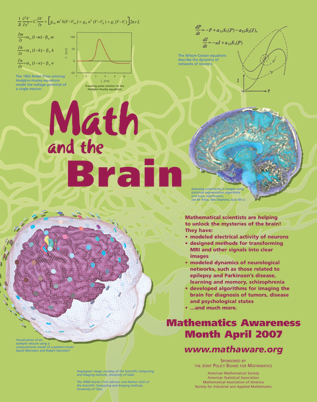MATHEMATICS AWARENESS MONTH 2007
The American Mathematical Society, the American Statistical Association, the Mathematical Association of America, and the Society for Industrial and Applied Mathematics announce that the theme for Mathematics Awareness Month 2007 is Mathematics and the Brain.
 One of the most exciting challenges in modern science
is to fully understand the human brain and its mechanisms.
Mathematics plays a vital role in this research to understand
the mechanisms and function of the human brain from its
smallest components to the whole brain.
One of the most exciting challenges in modern science
is to fully understand the human brain and its mechanisms.
Mathematics plays a vital role in this research to understand
the mechanisms and function of the human brain from its
smallest components to the whole brain.
Mathematical models continue to play a central role in understanding brain cells, their interaction, and their function. The 1963 Nobel Prize was awarded to Alan Lloyd Hodgkin and Andrew Huxley for a model that uses differential equations to approximate the electrical characteristics of excitable cells. Their original model described the ionic mechanisms underlying the initiation and propagation of action potentials in the squid giant axon and led to many later developments to model brain activity at the single neuron level.
Modeling and computational simulation have complemented laboratory experiments to understand how the brain functions at many levels from single cells and clusters to large networks of interacting cells.
Theoretical models and computational methods, along with experiments guided by these models, are used to unravel the circuitry of the cerebral cortex, the rules by which this circuitry develops and self-organizes, and its computational functions.
Research in the dynamics of networks is helping to understand, at a cellular and network level, how widespread synchronous patterns arise in large non-homogeneous networks, such as the brain. Such widespread synchronization of rhythmic activity among networks of neurons that normally function to produce distinct behavior may help explain disorders such as generalized epilepsy and Parkinson's disease, for example.
Imaging provides a non-invasive method for gathering information on brain activity and form and provides information used to infer function.
Imaging methods depend heavily on mathematics and computational tools. While each imaging modality uses different mathematical methods, each must combine and process raw sensor data to form coherent and meaningful images. Many new imaging methods are used to study properties of the brain. For example, diffusion tensor MRI (magnetic resonance imaging) is used to analyze the structure of white matter in the brain. Imaging methods, like diffusion MRI, offer means to non-invasively study the microstructure of biological tissues, enabling better understanding of the anatomical relationships between various functional areas of the brain. This allows scientists to map and quantify the connectivity between different brain regions.
The imaging itself also raises mathematical and computational challenges. A typical fMRI (functional MRI) experiment may collect as much as or more than 1 gigabyte per hour, calling for new statistical analysis techniques to analyze large volumes of data. The complexity and shear volume of the data require new mathematical tools for processing and analyzing the information while the data points to the need for new models.
Mathematics plays a central role in modeling, analyzing, and understanding the underlying structure and function of various regions of the brain and the interaction among these regions. Further research in the underlying mathematics of dynamical systems and networks, statistical methods, and mathematical tools for enhancing imaging will continue to help advance our understanding of our closest of all frontiers.
